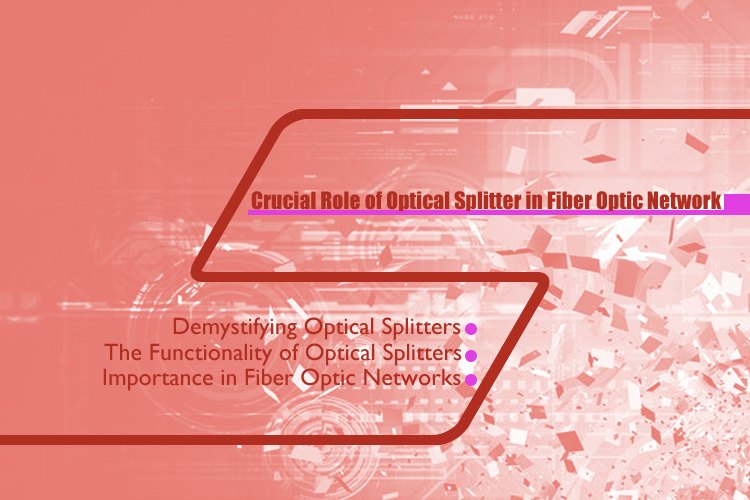By goodvin | 26 March 2024 | 0 Comments
The Vital Role of Optical Splitters in Fiber Optic Networks
Illuminating the Path: How Optical Splitters Drive Fiber Optic Networks
Introduction
Welcome to the realm of fiber optics, where the magic of high-speed data transmission happens. In this digital age, optical splitters play a vital role in ensuring that data flows seamlessly through fiber optic networks, enabling connectivity on a whole new level.

Section 1: Demystifying Optical Splitters
Optical splitters, commonly referred to as beam splitters in the professional realm, play a pivotal role in the field of optical signal distribution. These passive devices serve the purpose of dividing a single optical signal into multiple signals, facilitating efficient distribution across various locations. By eliminating the necessity for supplementary active components, optical splitters streamline the signal distribution process, enhancing overall system simplicity and reliability.
The versatility of optical splitters is evident in their diverse configurations, ranging from the fundamental 1x2 splitter to more intricate setups like 1x4 and 1x8 variants. The choice of configuration is dictated by the specific requirements of the application, with the number of output ports directly correlating to the splitter configuration. Understanding the nuances of these configurations is essential for professionals working in optical signal distribution, as it enables them to optimize signal routing and ensure seamless communication across networks.
Section 2: The Functionality of Optical Splitters
Optical splitters work based on the principles of light reflection, refraction, and interference. By splitting the incoming signal into multiple signals of carefully controlled power ratios, optical splitters enable data transmission to multiple end-users simultaneously over a single fiber strand.
The splitting process is achieved either via fused tapered fibers or advanced micro-optic integration in planar lightwave circuits. Precise dimensioning and geometric tolerances during fabrication ensure uniform splitting ratios are consistently replicated across numerous production runs. This reproducibility is critical for telecom applications requiring stable power budgets over splits spanning long reach networks.
They help in optimizing the efficiency of fiber optic networks by reducing the need for individual fibers to be deployed for each connection. This fiber sparing translates to significant cost savings both in material and trenching costs for outside plant deployments. Optical splitters also improve flexibility by allowing connectivity to be rapidly provisioned through simple reconfiguration rather than installing new fiber. Their density advantages are most apparent in tight equipment spaces such as central offices, data center switching closets and fiber distribution hubs.
Proper selection of splitters matched to network architecture, connectorization, cabling infrastructure and optical power design parameters is essential for ensuring reliability and performance objectives are consistently met in even the most demanding telecom application environments.
Section 3: Importance in Fiber Optic Networks
Optical splitters are indispensable components in passive optical networks (PONs), which have revolutionized the telecommunications industry and transformed the way we access high-speed internet and cable television services. These compact devices play a pivotal role in expanding the reach of fiber optic networks by efficiently distributing optical signals over extensive distances.
The significance of optical splitters lies in their ability to divide a single optical signal into multiple identical copies, allowing for the simultaneous transmission of data to multiple users or devices. This feature is particularly crucial in PON architectures, where a single optical fiber from a central office is split into multiple branches to serve multiple subscribers within a specific geographical area.
By employing optical splitters, network providers can significantly reduce the amount of fiber optic cabling required, leading to substantial cost savings in infrastructure deployment and maintenance. Additionally, optical splitters simplify network architecture by eliminating the need for bulky and power-hungry active components such as repeaters and amplifiers, further enhancing the cost-effectiveness of PONs.
Furthermore, optical splitters contribute to the scalability of fiber optic networks by enabling the flexible expansion of network capacity to accommodate growing subscriber demands. The modular nature of optical splitters allows for easy integration of additional splitters as the network expands, ensuring a seamless and efficient upgrade path.
Conclusion
As we navigate the digital landscape powered by fiber optic technology, the significance of optical splitters cannot be understated. These unassuming yet indispensable devices form the backbone of efficient data transmission, connecting the world like never before.
Tags: optical splitter, fiber optic network, data transmission, passive optical networks, telecommunications
Leave a Reply
Your email address will not be published.Required fields are marked. *
POPULAR BLOG
- The Future of Fiber Optic Access Networks: An Expert Perspective
- Market Analysis of Fiber Optic Testing Equipment: Key Trends and Insights
- Will SDM Technology Become the Only Way for High-Capacity Optical Transmission?
- Fiber Optic Network Development Strategy and Technical Roadmap
- Impact of Technical Innovation of Optical WDM on the Future of Optical Communication